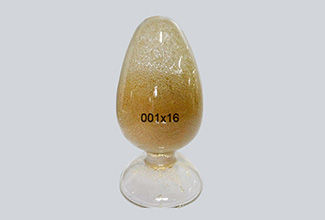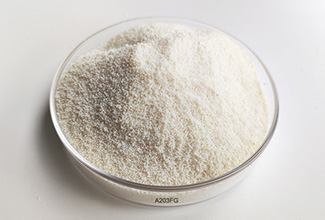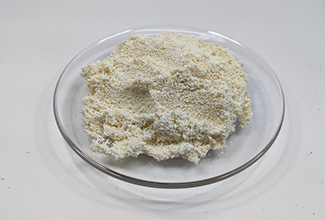What are the Different Types of Mixed Bed Resin?
Mixed Bed: Generally refers to an ion exchange column, which is a columnar pressure vessel used for ion exchange reactions, and is the exchange equipment for the tube-column method of ion exchange. It is often used in laboratory and industry. According to the regeneration mode can be divided into in vivo regeneration mixed bed, in vitro regeneration mixed bed, negative resin external transfer regeneration mixed bed three, in the scope of use can be divided into laboratory ion exchange column, industrial ion exchange column.
Resin bed: Ion exchange resin has exchange capacity and a series of other excellent performance, in order to put into practice, it is appropriate to use dynamic continuous exchange method and the corresponding device, the electrolyte solution to be processed for exchange, separation, concentration, adsorption. Research, design and practical demonstrated that the column or tower filled with ion exchange resin is the most effective. This kind of column or tower is called resin bed, also often called exchange column (exchange column), exchange tower (exchange tower).
Polished mixed bed: also known as disposable mixed bed general situation used in the end of the process, used to further improve the quality of produced water. The resin of polished mixed bed generally cannot be regenerated and reused. The so-called polishing is the surface treatment of the resin.
Ordinary mixed-bed system: A system in which water passes sequentially through a cation bed containing hydrogen-type cation exchange resins and an anion bed containing hydroxide-type anion exchange resins. The hydrogen-type cation exchange bed is used to remove cations from the water; the hydroxide-type anion exchange bed is used to remove anions from the water, and the mineral salts in the water are basically removed by the mixed bed. In order to obtain better desalination effect, the cation bed is loaded with strong acid cation exchange resin, and the anion bed is generally loaded with strong alkali anion exchange resin. Mixed beds are also divided into in vivo synchronous regeneration type mixed beds and in vitro regeneration type mixed beds.
Mixed bed resins are divided into ordinary Mixed Bed Resins and Polishing Resins.
The difference between the two:
1. Different definitions
Polishing resins are a mixture of [hydrogen-type strong acid cation exchange resins] and [hydrogen-type strong base anion exchange resins]. They are generally used at the end of ultrapure water treatment systems, that is, a step or process of water treatment to ensure that the water quality of the system outlet can maintain the water use standard. It is a single ion exchange resin with high specificity, which can remove some difficult-to-remove ions in water, such as dissolved organic matter, heavy metal ions, etc. Polishing resin can make water reach very high purity requirements, and its exchange capacity is relatively small.
Ordinary mixed bed resin refers to a ready-to-use resin composed of [gel-type strong acid cation exchange resin] and [strong base anion exchange resin] and has been regenerated and pre-mixed. It is mainly used in the water purification industry to polish process water to achieve demineralized water quality. It has a high exchange capacity and a wider range of applicability, and can remove more types of ions, such as carbonates, nitrates, sulfates, ammonium salts, etc. Mixed bed resins are usually used in the first few steps of water treatment to remove most of the ions, thereby reducing the burden of subsequent treatment steps.
2. Different performance characteristics
Polishing resin is usually a separate ion exchange bed used to remove residual anions and cations in water. This resin bed can only remove one of the ions, so it is usually necessary to add a neutralization bed between the two beds to ensure the purification of water quality. The advantage of polishing resin is that it can achieve good purification effects at a lower cost, but since it can only remove one of the ions, it is not very practical in applications that require high-purity water.
Ordinary mixed bed resins are usually a bed mixed with anion and cation exchange resins, which can remove cations and anions at the same time. This resin bed can produce very high purity water and is ideal for producing high-purity water. However, the cost of mixed bed resins is relatively high, and during use, due to the mixed nature of the bed, when the exchange resin reaches a certain degree of saturation, it needs to be replaced or regenerated frequently, so the maintenance cost is also relatively high.
3. Different application scenarios
Polishing resin generally produces water with a water quality of more than 18 megohms, with very high quality, and has a certain control ability over TOC and SIO2. The ion forms of polishing resins are H and OH types when they leave the factory, and they can be used after filling without regeneration. It is generally used in the semiconductor industry.
Ordinary mixed bed resins are generally suitable for water with more cations and anions, because mixed bed resins are highly transformed and specially purified, and mixed and compounded according to specific chemical equivalents, so they are suitable for various water treatment fields with high water requirements and no high regeneration conditions. It is also renewable. The main industry fields include ultrapure water production, demineralization, condensate polishing (boiler feed water), microelectronics cleaning, pharmaceuticals, etc.
Ordinary ion exchange resins only have one of anion resins and cation resins, which can effectively remove anions or cations in water. Due to different applications, the water quality resistivity of general ion exchange resins will not be too high, and they are often used in general industrial and living water treatment industries, such as industrial water treatment, pharmaceutical industry, pure water preparation, ultrapure water preparation, wastewater treatment, drinking water softening, food industry water treatment, etc. For example, the water softening resin we commonly use is a weakly acidic cationic resin, which is mainly used to exchange calcium and magnesium ions in water and reduce the hardness of water.
Resin bed: Ion exchange resin has exchange capacity and a series of other excellent performance, in order to put into practice, it is appropriate to use dynamic continuous exchange method and the corresponding device, the electrolyte solution to be processed for exchange, separation, concentration, adsorption. Research, design and practical demonstrated that the column or tower filled with ion exchange resin is the most effective. This kind of column or tower is called resin bed, also often called exchange column (exchange column), exchange tower (exchange tower).
Polished mixed bed: also known as disposable mixed bed general situation used in the end of the process, used to further improve the quality of produced water. The resin of polished mixed bed generally cannot be regenerated and reused. The so-called polishing is the surface treatment of the resin.
Ordinary mixed-bed system: A system in which water passes sequentially through a cation bed containing hydrogen-type cation exchange resins and an anion bed containing hydroxide-type anion exchange resins. The hydrogen-type cation exchange bed is used to remove cations from the water; the hydroxide-type anion exchange bed is used to remove anions from the water, and the mineral salts in the water are basically removed by the mixed bed. In order to obtain better desalination effect, the cation bed is loaded with strong acid cation exchange resin, and the anion bed is generally loaded with strong alkali anion exchange resin. Mixed beds are also divided into in vivo synchronous regeneration type mixed beds and in vitro regeneration type mixed beds.
Mixed bed resins are divided into ordinary Mixed Bed Resins and Polishing Resins.
The difference between the two:
1. Different definitions
Polishing resins are a mixture of [hydrogen-type strong acid cation exchange resins] and [hydrogen-type strong base anion exchange resins]. They are generally used at the end of ultrapure water treatment systems, that is, a step or process of water treatment to ensure that the water quality of the system outlet can maintain the water use standard. It is a single ion exchange resin with high specificity, which can remove some difficult-to-remove ions in water, such as dissolved organic matter, heavy metal ions, etc. Polishing resin can make water reach very high purity requirements, and its exchange capacity is relatively small.
Ordinary mixed bed resin refers to a ready-to-use resin composed of [gel-type strong acid cation exchange resin] and [strong base anion exchange resin] and has been regenerated and pre-mixed. It is mainly used in the water purification industry to polish process water to achieve demineralized water quality. It has a high exchange capacity and a wider range of applicability, and can remove more types of ions, such as carbonates, nitrates, sulfates, ammonium salts, etc. Mixed bed resins are usually used in the first few steps of water treatment to remove most of the ions, thereby reducing the burden of subsequent treatment steps.
2. Different performance characteristics
Polishing resin is usually a separate ion exchange bed used to remove residual anions and cations in water. This resin bed can only remove one of the ions, so it is usually necessary to add a neutralization bed between the two beds to ensure the purification of water quality. The advantage of polishing resin is that it can achieve good purification effects at a lower cost, but since it can only remove one of the ions, it is not very practical in applications that require high-purity water.
Ordinary mixed bed resins are usually a bed mixed with anion and cation exchange resins, which can remove cations and anions at the same time. This resin bed can produce very high purity water and is ideal for producing high-purity water. However, the cost of mixed bed resins is relatively high, and during use, due to the mixed nature of the bed, when the exchange resin reaches a certain degree of saturation, it needs to be replaced or regenerated frequently, so the maintenance cost is also relatively high.
3. Different application scenarios
Polishing resin generally produces water with a water quality of more than 18 megohms, with very high quality, and has a certain control ability over TOC and SIO2. The ion forms of polishing resins are H and OH types when they leave the factory, and they can be used after filling without regeneration. It is generally used in the semiconductor industry.
Ordinary mixed bed resins are generally suitable for water with more cations and anions, because mixed bed resins are highly transformed and specially purified, and mixed and compounded according to specific chemical equivalents, so they are suitable for various water treatment fields with high water requirements and no high regeneration conditions. It is also renewable. The main industry fields include ultrapure water production, demineralization, condensate polishing (boiler feed water), microelectronics cleaning, pharmaceuticals, etc.
Ordinary ion exchange resins only have one of anion resins and cation resins, which can effectively remove anions or cations in water. Due to different applications, the water quality resistivity of general ion exchange resins will not be too high, and they are often used in general industrial and living water treatment industries, such as industrial water treatment, pharmaceutical industry, pure water preparation, ultrapure water preparation, wastewater treatment, drinking water softening, food industry water treatment, etc. For example, the water softening resin we commonly use is a weakly acidic cationic resin, which is mainly used to exchange calcium and magnesium ions in water and reduce the hardness of water.
Next Article :
Related Products
-
 001x16 Strong Acid Cation Exchange ResinAppearance: Claybank to tan transparent spherical particle.The degree of crosslinking : 16%.Ionic form:Na+
001x16 Strong Acid Cation Exchange ResinAppearance: Claybank to tan transparent spherical particle.The degree of crosslinking : 16%.Ionic form:Na+ -
 A203FG Food Grade Macroporous Strong Base AnionAppearance: Milky white opaque spherical particleIonic form:Cl-Volume complete exchange capacity(mmol/ml):≥1.2
A203FG Food Grade Macroporous Strong Base AnionAppearance: Milky white opaque spherical particleIonic form:Cl-Volume complete exchange capacity(mmol/ml):≥1.2 -
 DA860 Acrylic Anion Exchange Adsorbent ResinAppearance: Milky white to Light yellow opaque sphericalIonic form:Cl-Volume complete exchange capacity(mmol/ml):≥1.6
DA860 Acrylic Anion Exchange Adsorbent ResinAppearance: Milky white to Light yellow opaque sphericalIonic form:Cl-Volume complete exchange capacity(mmol/ml):≥1.6
Message

